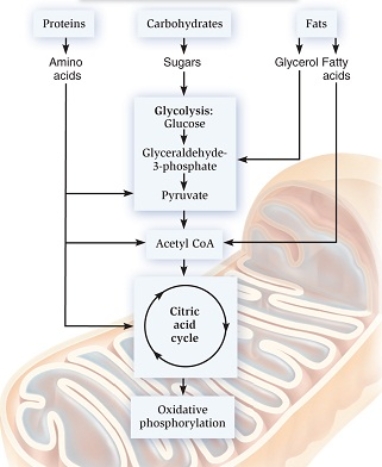A) substrate-level phosphorylation.
B) chemiosmosis.
C) photophosphorylation.
D) electron transport.
E) oxidation of NADH to NAD+.
G) A) and C)
Correct Answer

verified
Correct Answer
verified
True/False
Substrate phosphorylation occurs when protons pass through ATP synthase and combine with oxygen to make water.
B) False
Correct Answer

verified
Correct Answer
verified
True/False
During the energy investment phase of glycolysis,glucose has a decrease in free energy.
B) False
Correct Answer

verified
Correct Answer
verified
Multiple Choice
In ALL exergonic reactions,
A) the products have more total energy than the reactants.
B) the reactions are nonspontaneous.
C) the reaction proceeds with a net release of free energy.
D) a net input of energy from the surroundings is required for the reactions to proceeD.
E) some reactants will be converted to products.
G) A) and D)
Correct Answer

verified
Correct Answer
verified
Multiple Choice
What are the final by-products of glucose oxidation during aerobic cell respiration?
A) ATP,heat,and carbon dioxide
B) both ATP and heat only
C) carbon dioxide only
D) heat only
E) ATP only
G) A) and B)
Correct Answer

verified
Correct Answer
verified
Multiple Choice
 The conversion of pyruvate to acetyl CoA is irreversible.Predict what would happen to fatty acids as a result of this.
The conversion of pyruvate to acetyl CoA is irreversible.Predict what would happen to fatty acids as a result of this.
A) Fatty acids cannot be converted into carbohydrates.
B) Fatty acids cannot be metabolized in the citric acid cycle.
C) Fatty acids can be metabolized in glycolysis.
D) Fatty acids can be converted into carbohydrates.
F) C) and D)
Correct Answer

verified
Correct Answer
verified
Multiple Choice
Water held behind a dam would best reflect
A) chemical energy.
B) mechanical energy.
C) heat energy.
D) kinetic energy.
E) potential energy.
G) D) and E)
Correct Answer

verified
Correct Answer
verified
True/False
For a reaction to be spontaneous it must show a net decrease in both energy and entropy.
B) False
Correct Answer

verified
Correct Answer
verified
Multiple Choice
Which would be TRUE if an inhibitor blocked the activity of mitochondrial ATP synthase?
A) The pH in the space between the mitochondrial membranes would decrease.
B) The pH in the space between the mitochondrial membranes would increase.
C) Oxygen consumption would decrease.
D) ATP synthesis would increase.
E) The concentration of NADH would increasE.
G) B) and C)
Correct Answer

verified
Correct Answer
verified
Multiple Choice
How many ATP and NADH molecules are produced from each molecule of glucose in the citric acid cycle only?
A) 1 ATP,2 NADH
B) 2 ATP,6 NADH
C) 3 ATP,4 NADH
D) 0 ATP,6 NADH
E) 4 ATP,2 NADH
G) B) and E)
Correct Answer

verified
Correct Answer
verified
Multiple Choice
The charge on amino acids in the active site of an enzyme would be affected by
A) substrate concentration.
B) antibiotics.
C) salt concentration.
D) temperature.
E) pH.
G) C) and E)
Correct Answer

verified
Correct Answer
verified
Multiple Choice
The formation of each pyruvate in glycolysis also produces a net of 2 NADH and 2 ATP.However,each metabolism of glucose produces a net of 4 NADH and 4 ATP.How is this explained?
A) Glucose is cleaved into two three carbon sugars that are metabolized into pyruvate.
B) Pyruvate can also be fermented,which decreases the energy produced.
C) Glucose is metabolized by a different,more efficient pathway than pyruvate.
D) Energy is added to glucose which increases the amount of ATP produced per glucose molecule.
F) A) and B)
Correct Answer

verified
Correct Answer
verified
Multiple Choice
The equation,C6H12O6 + 6O2 6CO2 + 6H2O (ATP + Heat) ,describes what process?
A) photosynthesis
B) anaerobic metabolism
C) glycolysis
D) cell fermentation
E) cell respiration
G) A) and D)
Correct Answer

verified
Correct Answer
verified
True/False
The electron transport chain consists of a series of redox reactions in which electrons are transferred to oxygen as the final electron acceptor.
B) False
Correct Answer

verified
Correct Answer
verified
Multiple Choice
What would your predict about the reaction: ?
A) It can be used to drive endergonic reactions.
B) It yields energy.
C) It has a change in free energy that is greater than 0,and hence can be used to drive endergonic reactions.
D) It has a change in free energy that is greater than 0.
E) It has a change in free energy that is less than 0.
G) None of the above
Correct Answer

verified
Correct Answer
verified
True/False
In prokaryotic cells,the electron transport system occurs in the mitochondria.
B) False
Correct Answer

verified
Correct Answer
verified
Multiple Choice
What would you predict about a reaction that has a ?G 0?
A) The reaction will require energy and is spontaneous.
B) The reaction will require energy.
C) The reaction will yield energy.
D) The reaction is spontaneous.
E) The reaction will yield energy and is spontaneous.
G) C) and E)
Correct Answer

verified
Correct Answer
verified
Multiple Choice
Which reaction would require being coupled to the hydrolysis of at least two ATP molecules ( G = -14.6 kCal) in order to occur?
A) G = -14.6 kCal
B) G = -8 kCal
C) G = +8 kCal
D) G = +16 kCal
E) G = -16 kCal
G) A) and D)
Correct Answer

verified
Correct Answer
verified
Multiple Choice
In the citric acid cycle,malate is oxidized to form
A) succinate.
B) fumarate.
C) malate.
D) oxaloacetate.
E) citratE.
G) B) and D)
Correct Answer

verified
Correct Answer
verified
True/False
When a molecule of NAD+ gains a hydrogen atom,the molecule becomes reduced.
B) False
Correct Answer

verified
Correct Answer
verified
Showing 41 - 60 of 74
Related Exams